QUOTE ME
Now!

Every year the UK produces around 50 million scrap tyres. Also known as end of life tyres (ELTs) they represent a major challenge to the circular economy where waste is converted into a resource. Scrap tyres are recycled in two different ways; reuse and reprocessing. Envirotyre specialises in reuse.
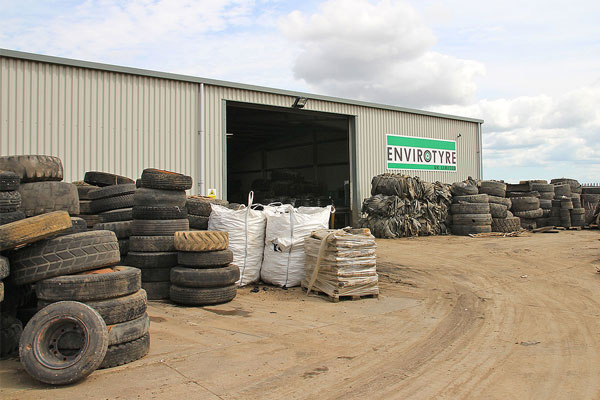
A waste tyre can be reused in two ways; as an alternative fuel or a construction material. Nearly 40,000 tyres per day are used as alternative fuel, the heat produced by burning one tyre being the equivalent of burning over 7 litres of oil. With a calorific value equivalent to that of good quality coal, end of life tyres are used as an alternative to fossil fuels, with the advantage of lower emissions.
Envirotyre collects and processes end of life tyres and tracks for reuse as a construction material, or export for use as a fossil fuel alternative. Envirotyre is not involved in reprocessing waste tyres.
Tyre bales are the product of our recycling process. This energy efficient way of processing scrap tyres produces high quality bales to BSI PAS 108. This type of bale is in the List of Wastes (LoW) Regulations under the waste code 160103 - baled end-of-life tyres. As such they can be used in construction. If waste tyres are being transported over some distance, baling them prior to transport reduces their bulk by up to 80% with a similar reduction in transport costs.
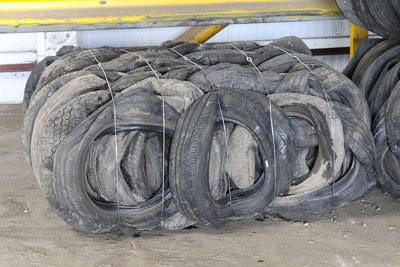
Tyre bales are produced from car and truck tyres, but these can't be mixed within a bale.
A car tyre bale contains between 100 and 115 tyres, depending on the size of the tyres. Specialist tyre baling machines produce the bales using powerful hydraulic rams to compress the tyres once they have been loaded in a specific sequence.
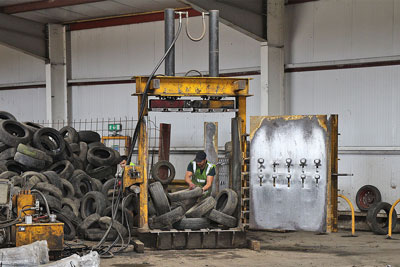
The baler's chamber is 1.55 metres wide and 0.75 metres front to back. The chamber is 2.0 metres high and after compression the waste tyre stack will be down to 1.2 metres high. Note the herringbone pattern of the waste tyres, this makes the bale stable.
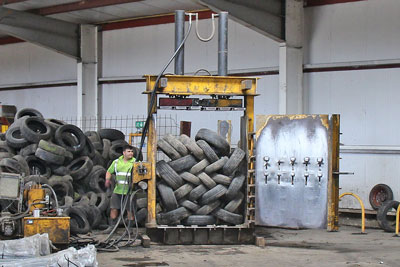
Five tie wires secure the bale. In this picture you can see them laid at the bottom of the bale, before the door closes. When the baling process is complete the bale is tipped out of the baler and has a footprint of 1.5m by 1.2m and a height of 0.75m.
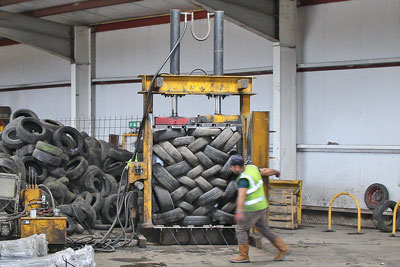
A bale produced from truck tyres will be dimensionally the same as a car tyre bale but only contain around 18 tyres. An additional process removing the tyre's side-walls is required prior to compression and banding.
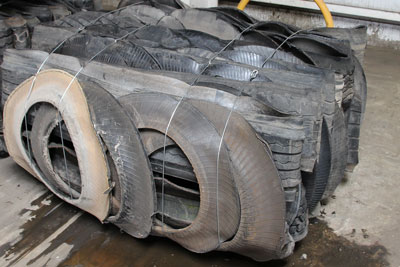
It is deemed that used tyres are neither hazardous nor dangerous, so long as normal precautions are followed for treatment, processing, storage and use.
As tyres do not spontaneously combust the main fire risk is arson. As a licensed site Envirotyre follows the Home Office guidance on fire safety for tyre sites. However, igniting tyre bales deliberately is difficult, impossible if they are buried in construction work. Research has shown that igniting tyre bales is much more difficult than granular tyre product or loose tyres and burning rates of bales much slower. Evidence suggests that tyre bales present the lowest fire risk of all tyre products.
Tyre bales weigh around 800 kilograms so must be handled using mechanical handling equipment. Up to 26 bales can be fitted within a standard shipping container, the equivalent of 2600 car tyres, four or five times the number of loose tyres that could be contained.
This makes baled tyres far more economical to transport.
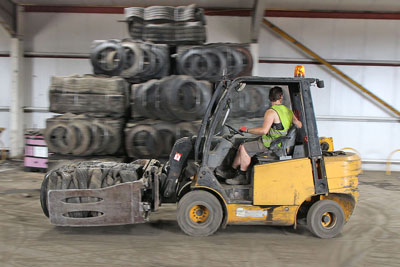
Tyre bales are the product of our recycling process. This energy efficient way of processing scrap tyres produces high quality bales to BSI PAS 108. This type of bale is in the List of Wastes (LoW) Regulations under the waste code 160103 - baled end-of-life tyres. As such they can be used in construction. If waste tyres are being transported over some distance, baling them prior to transport reduces their bulk by up to 80% with a similar reduction in transport costs.

Tyre bales are produced from car and truck tyres, but these can't be mixed within a bale.
A car tyre bale contains between 100 and 115 tyres, depending on the size of the tyres. Specialist tyre baling machines produce the bales using powerful hydraulic rams to compress the tyres once they have been loaded in a specific sequence.

The baler's chamber is 1.55 metres wide and 0.75 metres front to back. The chamber is 2.0 metres high and after compression the waste tyre stack will be down to 1.2 metres high. Note the herringbone pattern of the waste tyres, this makes the bale stable.

Five tie wires secure the bale. In this picture you can see them laid at the bottom of the bale, before the door closes. When the baling process is complete the bale is tipped out of the baler and has a footprint of 1.5m by 1.2m and a height of 0.75m.

A bale produced from truck tyres will be dimensionally the same as a car tyre bale but only contain around 18 tyres. An additional process removing the tyre's side-walls is required prior to compression and banding.

It is deemed that used tyres are neither hazardous nor dangerous, so long as normal precautions are followed for treatment, processing, storage and use.
As tyres do not spontaneously combust the main fire risk is arson. As a licensed site Envirotyre follows the Home Office guidance on fire safety for tyre sites. However, igniting tyre bales deliberately is difficult, impossible if they are buried in construction work. Research has shown that igniting tyre bales is much more difficult than granular tyre product or loose tyres and burning rates of bales much slower. Evidence suggests that tyre bales present the lowest fire risk of all tyre products.
Tyre bales weigh around 800 kilograms so must be handled using mechanical handling equipment. Up to 26 bales can be fitted within a standard shipping container, the equivalent of 2600 car tyres, four or five times the number of loose tyres that could be contained.
This makes baled tyres far more economical to transport.
